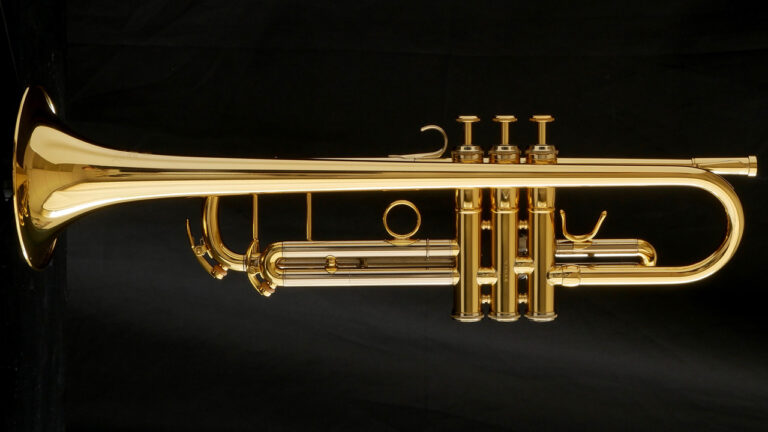First Steps
Learning to play the trumpet is an exciting journey, but it requires patience, dedication, and consistent practice. Below are the initial steps for effectively starting to play the trumpet:
1. Choosing the Trumpet
- Instrument Quality: If you are a beginner, it is advisable to choose a trumpet of intermediate quality. There are affordable models for beginners that are well-constructed.
- Check the Condition: Ensure that the trumpet is in good condition, with no leaks in the valves or mouthpiece area.
2. Familiarizing Yourself with the Trumpet
- Parts of the Trumpet: Learn the parts of the trumpet (mouthpiece, tubing, valves, slides) and how they work together to produce sound.
- Trumpet Position: Hold the trumpet correctly with your left hand (on the lower part of the instrument) and your right hand (on the valves). The position should be comfortable, with the trumpet parallel to the ground.
3. Learning to Place the Mouthpiece
- Mouthpiece Position: The mouthpiece should be positioned on the lower lip with light pressure, avoiding force. Practice attaching and removing the mouthpiece with ease.
- Pressure Control: Avoid excessive pressure, as this can cause discomfort in the lips and make sound production more difficult.
4. Producing the First Sounds
- Blowing Without the Valves: To start, try producing sound on the trumpet without pressing the valves. Simply blow through the mouthpiece, controlling the air pressure.
- Sound Refinement: Initially, the sound may be weak or crackling. This is normal and part of the process as your lips adapt to the instrument. Daily practice will improve sound quality.
5. Lip Technique (Embouchure)
- Lip Positioning: Embouchure is essential for producing a clean and strong sound. Your lips should vibrate as you blow air. There should be no excessive tension, but they should not be too loose either.
- Embouchure Practice: Try producing short, controlled sounds using only your lips, without engaging the valves at first.
6. First Exercises
- Long Tones: Start with long tones, which help develop air control and lip endurance.
- Basic Scales: Once you become familiar with sound production, begin practicing simple scales, such as the C major scale. This will help improve your intonation and the relationship between air pressure and valve control.
7. Using the Valves
- Understanding Valve Functions: The valves alter the trumpet’s pitch, making the note lower or higher. Over time, you will learn which combinations of valves produce different notes.
- Valve Practice: Start pressing the valves while playing scales. Each valve lowers the pitch of a note by a specific semitone.
8. Breathing Techniques
- Deep Breathing: Proper breathing is fundamental. Breathe deeply using your diaphragm, and release the air in a controlled manner. Good breathing technique helps maintain a strong, clear sound.
- Air Control: The more control you have over your airflow, the more consistent your sound will be.
9. Developing Muscle Memory
- Regular Practice: Consistent practice is crucial. Even if it’s only 20-30 minutes a day, the key is to be regular. This will help develop muscle memory and improve your performance on the trumpet.
- Relaxing the Lips: During practice, remember to relax your lips occasionally. Avoid excessive tension, as it can hinder your technique in the long run.
10. Lessons and Resources
- Trumpet Lessons: If possible, seek a trumpet teacher. Having someone correct your technique can accelerate your learning.
- Online Resources: Use tutorial videos, apps, and online courses, which can provide additional instruction and exercises to enhance your learning.
11. Listening to Music and Solists
- Listen to Professional Trumpeters: Listening to recordings of renowned trumpet players can be an excellent way to understand how the trumpet should sound and what you can aim to achieve.
- Imitate Sounds: Try to imitate the sounds and phrases of trumpet players you hear. This will help develop your musical ear and technique.
12. Attention to Comfort and Posture
- Upright Posture: Maintain a good posture while playing. Avoid slouching, and keep your shoulders relaxed.
- Be Aware of Fatigue: Avoid playing for long periods without rest. The lips can tire, which may lead to inaccurate playing or even injury if not properly cared for.
Summary:
- Choose a quality trumpet.
- Learn the correct trumpet position and embouchure.
- Practice blowing and controlling your breath.
- Start with simple scales and long notes.
- Progress to using the valves and technical exercises.
- Be consistent, practice daily, and learn from other trumpet players.
Patience is key—at the beginning, it may seem difficult, but with time and practice, you will improve on the trumpet!


